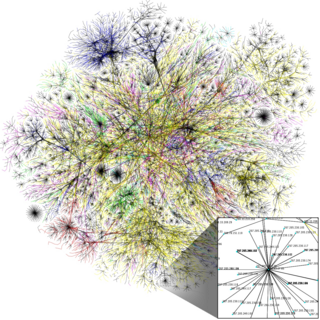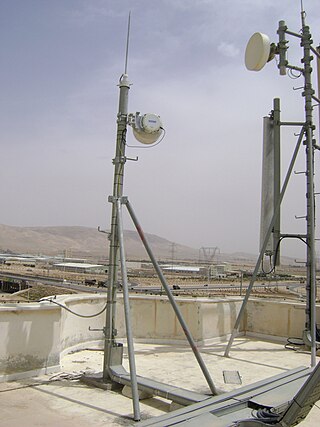Related Research Articles

Wireless broadband is a telecommunications technology that provides high-speed wireless Internet access or computer networking access over a wide area. The term encompasses both fixed and mobile broadband.

A wireless network is a computer network that uses wireless data connections between network nodes. Wireless networking allows homes, telecommunications networks, and business installations to avoid the costly process of introducing cables into a building, or as a connection between various equipment locations. Admin telecommunications networks are generally implemented and administered using radio communication. This implementation takes place at the physical level (layer) of the OSI model network structure.

Multichannel multipoint distribution service (MMDS), formerly known as broadband radio service (BRS) and also known as wireless cable, is a wireless telecommunications technology, used for general-purpose broadband networking or, more commonly, as an alternative method of cable television programming reception.
Wireless local loop (WLL) is the use of a wireless communications link as the "last mile / first mile" connection for delivering plain old telephone service (POTS) or Internet access to telecommunications customers. Various types of WLL systems and technologies exist.
The last mile, or last kilometer, in the telecommunications, cable television and internet industries refers to the final leg of a telecommunications network that delivers telecommunication services to retail end-users (customers). More specifically, last mile describes the portion of the telecommunications network chain that physically reaches the end-user's premises. Examples are the copper wire subscriber lines connecting landline telephones to the local telephone exchange; coaxial cable service drops carrying cable television signals from utility poles to subscribers' homes, and cell towers linking local cell phones to the cellular network. The word "mile" is used metaphorically; the length of the last mile link may be more or less than a mile. Because the last mile of a network to the user is conversely the first mile from the user's premises to the outside world when the user is sending data, the term first mile is also alternatively used.

Internet access is a facility or service that provides connectivity for a computer, a computer network, or other network device to the Internet, and for individuals or organizations to access or use applications such as email and the World Wide Web. Internet access is offered for sale by an international hierarchy of Internet service providers (ISPs) using various networking technologies. At the retail level, many organizations, including municipal entities, also provide cost-free access to the general public. Types of connections range from fixed-line cable to mobile and satellite.

A wireless Internet service provider (WISP) is an Internet service provider with a network based on wireless networking. Technology may include commonplace Wi-Fi wireless mesh networking, or proprietary equipment designed to operate over open 900 MHz, 2.4 GHz, 4.9, 5, 24, and 60 GHz bands or licensed frequencies in the UHF band, LMDS, and other bands from 6 GHz to 80 GHz.

Worldwide Interoperability for Microwave Access (WiMAX) is a family of wireless broadband communication standards based on the IEEE 802.16 set of standards, which provide physical layer (PHY) and media access control (MAC) options.
4G is the fourth generation of cellular network technology, succeeding 3G and designed to support all-IP communications and broadband services, enabling a variety of data-intensive applications. A 4G system must meet the performance requirements defined by the International Telecommunication Union (ITU) in IMT Advanced. 4G supports a range of applications, including enhanced mobile internet access, high-definition streaming, IP telephony, video conferencing, and the expansion of Internet of Things (IoT) applications.
The V band ("vee-band") is a standard designation by the Institute of Electrical and Electronics Engineers (IEEE) for a band of frequencies in the microwave portion of the electromagnetic spectrum ranging from 40 to 75 gigahertz (GHz). The V band is not heavily used, except for millimeter wave radar research and other kinds of scientific research. It should not be confused with the 600–1,000 MHz range of Band V of the UHF frequency range.
Hybrid fiber-coaxial (HFC) is a broadband telecommunications network that combines optical fiber and coaxial cable. It has been commonly employed globally by cable television operators since the early 1990s.

Fiber to the x or fiber in the loop is a generic term for any broadband network architecture using optical fiber to provide all or part of the local loop used for last mile telecommunications. As fiber optic cables are able to carry much more data than copper cables, especially over long distances, copper telephone networks built in the 20th century are being replaced by fiber.
In a hierarchical telecommunications network, the backhaul portion of the network comprises the intermediate links between the core network, or backbone network, and the small subnetworks at the edge of the network.

Cambium Networks Corporation is a wireless infrastructure provider that offers fixed wireless and Wi-Fi to broadband service providers and enterprises to provide Internet access. An American telecommunications infrastructure company, it provides wireless technology, including Enterprise WiFi, switching solutions, Internet of Things, and fixed wireless broadband and Wi-Fi for enterprises. Publicly traded on the NASDAQ stock exchange, it spun out of Motorola in October 2011.
Long-range Wi-Fi is used for low-cost, unregulated point-to-point computer network connections, as an alternative to other fixed wireless, cellular networks or satellite Internet access.

Fixed wireless is the operation of wireless communication devices or systems used to connect two fixed locations with a radio or other wireless link, such as laser bridge. Usually, fixed wireless is part of a wireless LAN infrastructure. The purpose of a fixed wireless link is to enable data communications between the two sites or buildings. Fixed wireless data (FWD) links are often a cost-effective alternative to leasing fiber or installing cables between the buildings.

Gigabit wireless is the name given to wireless communication systems whose data transfer speeds reach or exceed one gigabit per second. Such speeds are achieved with complex modulations of the signal, such as quadrature amplitude modulation (QAM) or signals spanning many frequencies. When a signal spans many frequencies, physicists refer that a wide bandwidth signal. In the communication industry, many wireless internet service providers and cell phone companies deploy wireless radio frequency antennas to backhaul core networks, connect businesses, and even individual residential homes.
International Mobile Telecommunications-Advanced are the requirements issued by the ITU Radiocommunication Sector (ITU-R) of the International Telecommunication Union (ITU) in 2008 for what is marketed as 4G mobile phone and Internet access service.
Citizens Broadband Radio Service (CBRS) is a 150 MHz wide broadcast band of the 3.5 GHz band in the United States. In 2017, the US Federal Communications Commission (FCC) completed a process which began in 2012 to establish rules for commercial use of this band, while reserving parts of the band for the US Federal Government to limit interference with US Navy radar systems and aircraft communications.
References
- ↑ Local Multipoint Distribution Service (LDMS), by Vinod Tipparaju, November 23, 1999, cis.ohio-state.edu via CiteseerX.
- ↑ "Local Multipoint Distribution Service". Federal Communications Commission . 30 July 2018. Retrieved January 12, 2021.
- ↑ Local Multipoint FCC LMDS Fact Sheet March 28, 1998